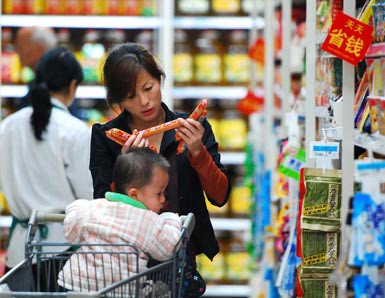In 2015, Chinese consumers spent US$1.97 Trillion (CNY12,986.7bn) on online and offline retail shopping, up to 9.5% from 2014 and 69.7% from 2010. However, growth in the retail industry has been decelerating as consumers become more conservative in spending in the current economic uncertainty. The rapid rise of Chinese stocks in the first half of 2015 had sparked more consumer spending, but that quickly dissolved with the unstable Chinese stock market. As physical store retailers adjust to an increasingly competitive landscape, they must take advantage of the e-commerce platform and meet changing consumer expectations.
Retail Industry in China and Consumer Overview
 The Chinese economy decelerated to 8% growth in 2015, compared to 10% in 2010 and 9% in 2011. Like the overall economy, the retail industry is also plateauing off and adjusting to this new period of the Chinese economy. There are over 6.26 million store retailers in China, with a combined US$1.6756 Trillion (CNY 11,036.6 bn) in offline sales in 2015, up 4.6% from 2014. However due to consumers cutting back on spending and the rise of e-commerce, many retail stores such as hypermarkets and apparel and footwear specialist retailers had to close down stores that they aggressively opened years before.
The Chinese economy decelerated to 8% growth in 2015, compared to 10% in 2010 and 9% in 2011. Like the overall economy, the retail industry is also plateauing off and adjusting to this new period of the Chinese economy. There are over 6.26 million store retailers in China, with a combined US$1.6756 Trillion (CNY 11,036.6 bn) in offline sales in 2015, up 4.6% from 2014. However due to consumers cutting back on spending and the rise of e-commerce, many retail stores such as hypermarkets and apparel and footwear specialist retailers had to close down stores that they aggressively opened years before.
The per capita disposable income of urban households in 2015 was US$4736.17 (CNY 31,195), representing a real growth of 6.6% from 2014. Along with rising standards of living, Chinese urban consumers are demanding enhanced convenience in their shopping experience, as well and better quality and more innovative products and services. Thus more domestic retailers are importing foreign goods, while foreign retailers are establishing Chinese stores. For instance, the Costo, the American wholesale retailer, recently opened up an online Tmall (Alibaba) store to better reach Chinese consumers.
See our latest video on Chinese Demographics. A Closer Look at Chinese Demographics
E-Commerce Rise for the Retail Industry in China
 While store-based retailers are struggling with decreasing consumer confidence and increasing costs of rent and labor, e-commerce is booming. Online retail generated US$272.48 Billion (CNY 1,794.7 bn) in sales in 2015, with a current value growth of 53%. As more Chinese get access to faster Internet speeds, more are choosing to bypass physical stores and shop online, which provides convenience and a large variety of products.
While store-based retailers are struggling with decreasing consumer confidence and increasing costs of rent and labor, e-commerce is booming. Online retail generated US$272.48 Billion (CNY 1,794.7 bn) in sales in 2015, with a current value growth of 53%. As more Chinese get access to faster Internet speeds, more are choosing to bypass physical stores and shop online, which provides convenience and a large variety of products.
Companies that used to focus solely on expanding physical stores to increase sales have now realized to improve their online presence as well. Many are combining e-commerce with physical stores to enhance shopper’s experience and streamline the product offerings. For example, the top retail companies such as China Resources Group, Sun Art Retail Group, and Walmart (China) Investment have online-to-offline (O2O) structures. They might also open up a brand store on Alibaba’s Tmall, instead of just selling its products through their official website.
Alibaba Group Holding dominates the Chinese Internet retail landscape, with Taobao and Tmall, and accounted for 46.9% of value in online retail sales in 2015. JD.com Inc, which also runs an online shopping platform like Tmall, followed with 20.1%.
It should be noted that Xiao Mi accounted for 3.3% and Apple 0.8% of all online retail value in 2015. This is remarkable because their websites only sell their own products, as opposed to the products of many brands such as Tmall.
Two particularly popular categories for online shopping are Apparel and Footwear and Consumer Electronics. In 2015, Apparel and Footwear had US$ 56.8 Billion (CNY 374.3 bn) sales and a 43% current value growth from 2014. Consumer Electronics had US$ 57.5 Billion (CNY 378.4 bn) sales, marking a 41% increase. The Chinese middle class is also spending more on food and home goods. Food and Drink grew 51.7% from 2014 to US$ 18 Billion (CNY 119 bn) and Home Care grew 50.3% to US$ 820 Million (CNY 5.4 bn.).
Building Mobile Commerce in China
Mobile commerce is also rising as Chinese urban shoppers use their phones to compare prices on the spot and search reviews. Mobile accounted for 51% of value in The Internet retailing in 2015 and is projected to account for 67% of all Internet retail by 2020. Retailers are targeting consumer with mobile apps for shopping and payments like Alibaba has done with its Taobao and Tmall e-commerce apps and Alipay payment app. Some others are taking advantage of WeChat’s in-app wallet payment feature, and creating WeChat specific stores in addition to online and app ones.
Winning through Ease of Shop
While online commerce has quickly arisen in the past few years, physical store retail is still vitally important and accounts for 85% of all value in retail sales. There are over 3.75 million grocery retailers and 2.5 million non-grocery retailers in China. Many consumers choose to visit a store to verify the quality of a product before purchasing online. Furthermore, designing a product’s packaging and strategically placing it in an eye-catching shelf in a physical retailer offers an advertising opportunity that online retail cannot.
Daxue Consulting offers store check services across China in more than 50 cities and helps businesses analyze their products’ visuals in store. Daxue can help its clients get in-depth knowledge on product availability, competitors with similar products, and other insights into boosting marketing and retail sales. Contact Daxue to know more about the Shopability strategy in China.
Although the retail industry has been decelerating, its e-commerce sector, in particular, has a lot of potentials for new business to enter and old businesses to expand their consumer base. As the Chinese middle class expands and increases its disposable income, the market for high quality and foreign goods, especially consumer electronics focused on health and home.
NB: 1 USD = 6.59 CNY




